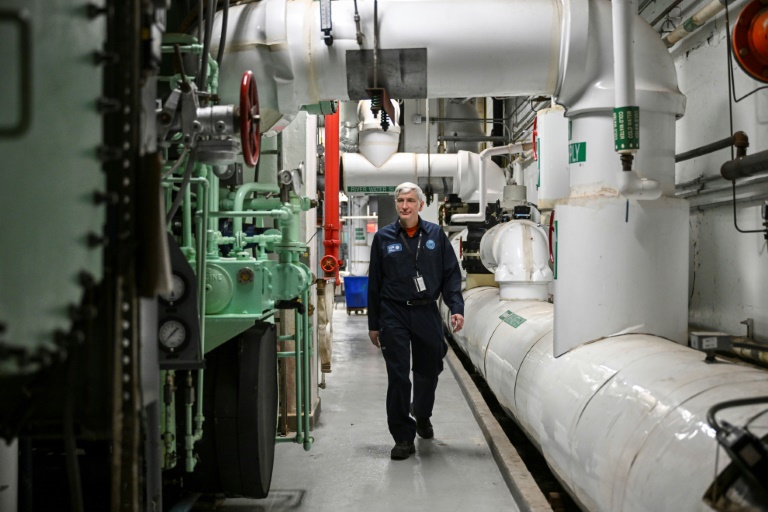At the bottom of the bowels of the UN seat, a pump aspire to huge amounts of water from the East river to help cool the complex with an old energy mechanism but energy efficient.
As more and more people want to stay cool in a planet that heats up regularly, energy experts indicate this type of water -based system as a good alternative to air conditioning. But in many cases, they are difficult to set up.
The system is part of the New York complex since its opening in the 1950s, the Chief Engineer Michael Martini told AFP during a visit to the cooling equipment.
The system, revised with the rest of the 2008 to 2014 complex, cools the United Nations center using less energy than a conventional air conditioning system. The United Nations Policy is to bring the air temperature to around 24 degrees Celsius, 75 degrees Fahrenheit.
In summer in New York, the river flowing next to the United Nations headquarters – it is in fact a salt water estuary – remains much fresher than the surrounding air, which can reach 100 degrees. So cool the building eats less energy.
Up to 26,000 liters per minute (7,000 gallons) of water circulation through fiberglass pipes to the complexing plant of the complex, which uses it and a refrigerant gas to produce cold.
The system has two independent loops to prevent the contamination of the water going up in the river at a higher temperature, said the cooling system, David Lindsay.
Looking at the brilliant glass tower of the United Nations Headquarters and the Dome of the General Assembly, you would never know that the East river serves this objective for the UN and more than part of the landscape.
The UN headquarters in New York is not its only building which depends on the water.
In Geneva, its nations palaces have a cooling system that uses Lake Lake water. And the United Nations City Complex in Copenhagen, which houses 10 UN agencies, depends on cold sea water which almost eliminates the need for electricity to cool the place.
This is a huge advantage compared to the two billion air conditioning units of two billion information in a world.
– Why so rare? –
With the number of air conditioners due to the increase in order to help people who are increasingly exposed to dangerous temperatures, energy consumption for cooling has already tripled since 1990, said the International Energy Agency, which wants more effective systems.
Examples of these are centralized air conditioning networks using electricity, geothermal systems or those that use water, such as the United Nations Complex in New York.
This last system “has not been deployed as much as it should be for the problems we face today,” said Lily Riahi, a coalition coordinator, a group of states, cities and businesses under the aegis of the United Nations.
Some large organizations have been able to manage such systems by themselves, such as the United Nations or Cornell University in New York State, which relies on Lake Cayuga water.
But for the most part, these systems require a lot of coordination between several stakeholders, said Riahi.
“We know that it is technically possible, and we actually know that there are many cases that also prove the economy,” said Rob Thornton, president of the International District Energy Association, which helps develop the district cooling and heating networks.
“But that requires someone, an agent, whether it is a champion, a city or a public service or someone, to undertake market aggregation,” he said.
“The challenge is simply to bring together and aggregate customers to the point where there are enough, where the risk can be managed,” said Thornton.
He cited Paris as an example, which uses the Seine river to manage the largest water -based cooling grid in Europe.
These networks allow the reduced use of toxic substances such as cooling liquids and reduce the risk of leaks.
And they avoid hot air emissions – as air conditioning units spit – in cities that already lasted heat waves.
But the hot water of cooling units, when spilled in rivers and other bodies of water, is dangerous for aquatic ecosystems, according to environmentalists.
“This challenge is quite low compared to the discharge of nuclear power plants,” said Riahi, adding that the problem can be resolved by fixing a temperate limit on this water.
USA / ICO / EML / DW / JBR


